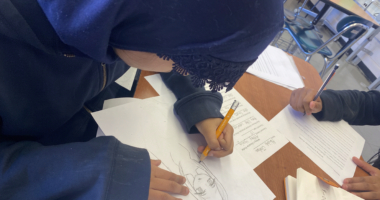Giving art a real chance in the classroom grants students access to define their success and identity. Funding for arts education has always been a struggle. Lately the tide seems to be changing. Leading the seachange is New York City Mayor Bill de Blasio, Comptroller Scott M. Stringer and Schools Chancellor Carmen Fariña. According to nyc.gov, “the City will spend an unprecedented $23 million in additional arts funding for New York City schools…improve arts facilities across the City, and foster exciting partnerships with some of the City’s renowned cultural institutions.”
Why does this matter?
I see firsthand how the infusion of art in a public school classroom can impact its students, particularly for students of color in under-resourced communities. Similar to athletics, an arguably more visible and attractive counterpart, arts integration can have a positive impact on student literacy, critical thinking and emotional intelligence. It can directly heighten leadership qualities, creativity and cultural awareness.
“I worry about putting him into the public school system. I was a teacher for many years. I’ve seen so much confidence destroyed by the standardized system. Every human is born with natural curiosity. I’ve never seen a child who wasn’t inspired. But once you force someone to do anything, the inspired person is killed.”
Grandfather kneeling next to his grandson in a public park. Courtesy of Humans of New York (6-20-14)“The arts education field citywide and nationally is beginning to understand that quantifiable data that discernibly shows this impact will further its relevance and legitimacy. I hope that continued funding will follow. This investment will be a game changer for tens of thousands of students across the city, giving them access to the well-rounded education they deserve and are entitled to by state law.”
Executive Director Eric Pryor, The Center for Arts Education (CAE)
This is an opportunity to level the playing fields for students of color. Students who have not yet found their voices. Students yearning to share who they are. Make no mistake — I’m not so naïve as to believe this only affects just how many future actors, musicians and visual artists will occupy cramped apartments in the far reaches of the so-called “outer boroughs”. I am talking about how in New York City and other big American cities, young people of color occupy schools in communities that are not prioritized.
So how can anyone expect an elementary school student to pull herself up by the bootstraps and change a system of selective neglect simply by passing all her tests?
Art provides an access point for students to come into their own and develop leadership and critical thinking skills. It can also contribute to a collaborative environment that develops one’s identity and elevates an investment in community. Exposure to the arts and access to one’s greatest self can eventually level the playing field in businesses across different sectors that currently see people of color truly in the minority.
In March of this year, finance executive Mellody Hobson had this to say at a Ted Talk.
“Now I know there are people out there who will say that the election of Barack Obama meant that it was the end of racial discrimination for all eternity, right? But I work in the investment business, and we have a saying: The numbers do not lie. And here, there are significant, quantifiable racial disparities that cannot be ignored, in household wealth, household income, job opportunities, healthcare. One example from corporate America: Even though white men make up just 30 percent of the U.S. population, they hold 70 percent of all corporate board seats. Of the Fortune 250, there are only seven CEOs that are minorities, and of the thousands of publicly traded companies today, thousands, only two are chaired by black women, and you’re looking at one of them, the same one who, not too long ago, was nearly mistaken for kitchen help.”
Mellody Hobson, Chairman of DreamWorks Animation, President of Ariel Investments
Art has a profound ability to empower, to change. For that reason, it is dangerous and enduring. NYC’s investment is a worthy first step in challenging an antiquated system. How heavily did test scores weigh in determining your success? How did you cope with finding your identity at an early age? In hindsight, how could you have benefitted from earlier exposure?
The legendary Maya Angelou had a wonderful answer to an insightful question from Dave Chappelle on Sundance TV’s Iconoclasts. I feel it’s best to be quiet now and listen.
Dave Chappelle:
“You’ve written books. You teach. And you’re from a time when the society would tell you that these types of things were probably not in the realm of possibility. The fact you even lived abroad, a global perspective, pre-globalization almost. What do you attribute that to?”Maya Angelou:
“I attribute that to love. Love is a condition so powerful. It may be that which holds the stars in the firmament. It may be that which pushes and urges the blood in the veins. Courage. You have to have courage to love somebody because you risk everything…Everything.”



